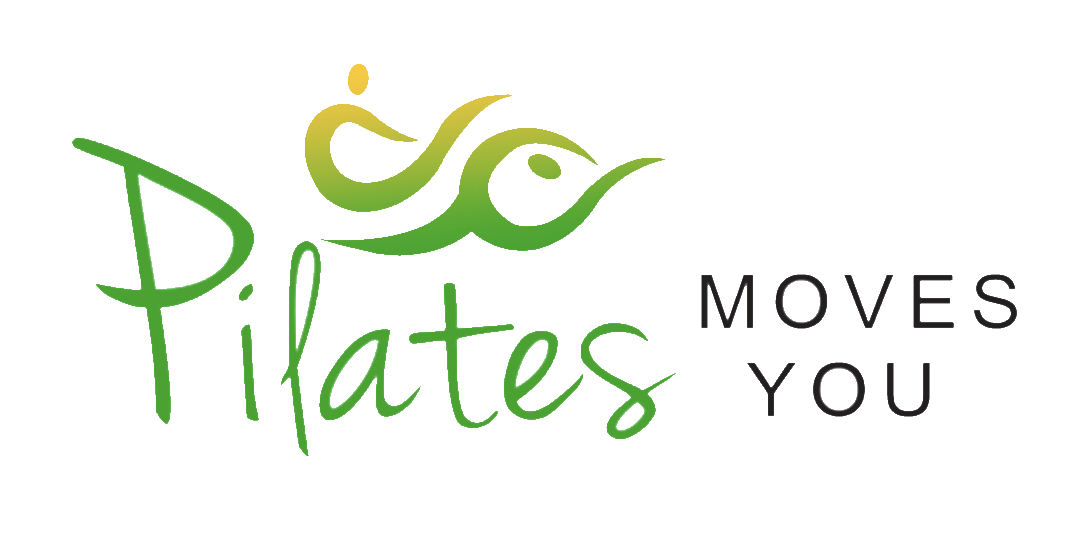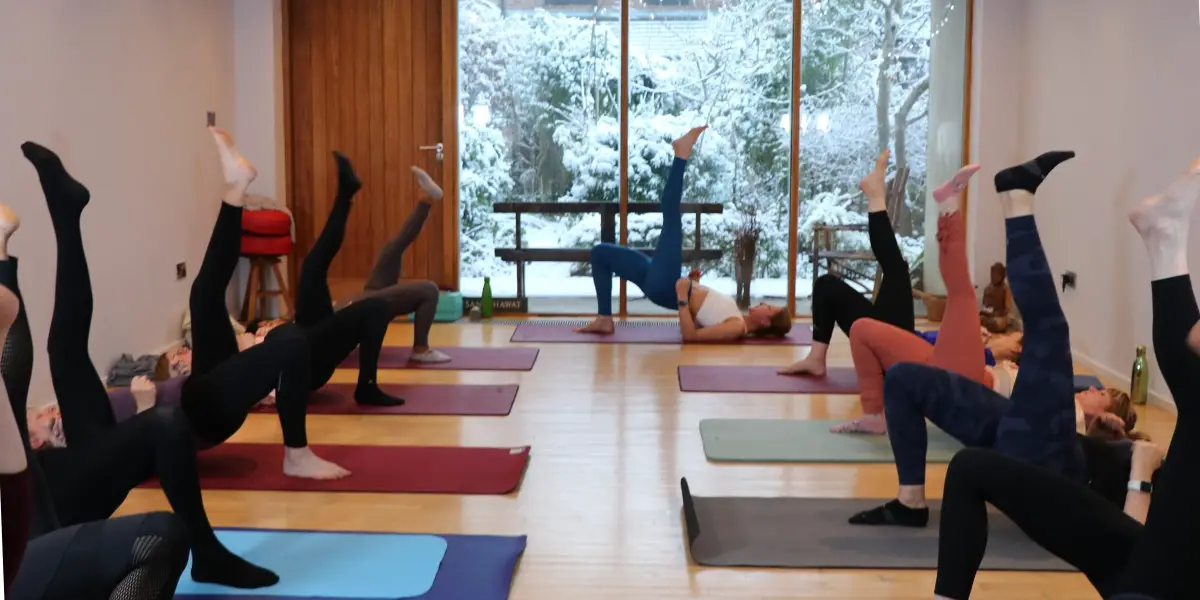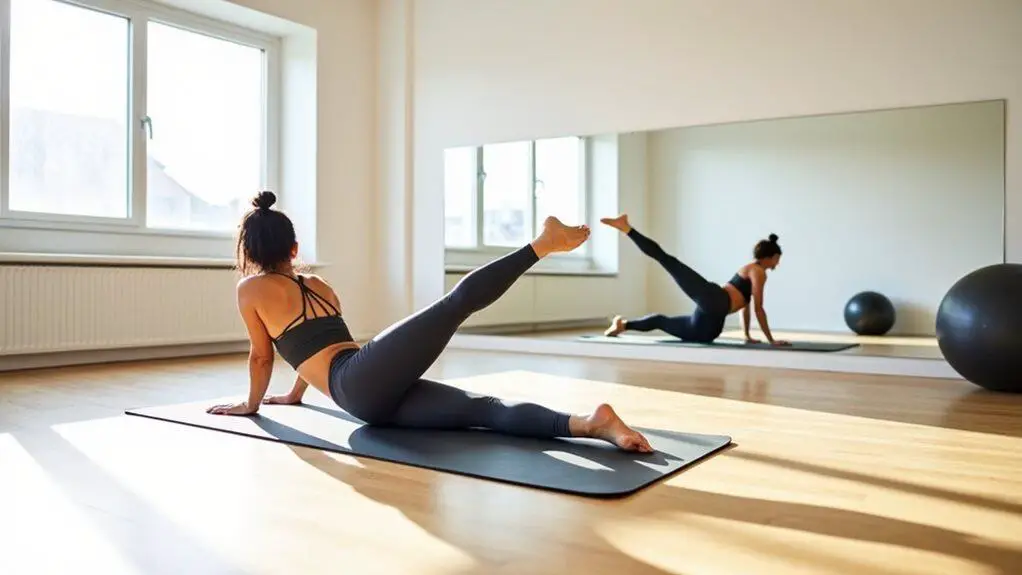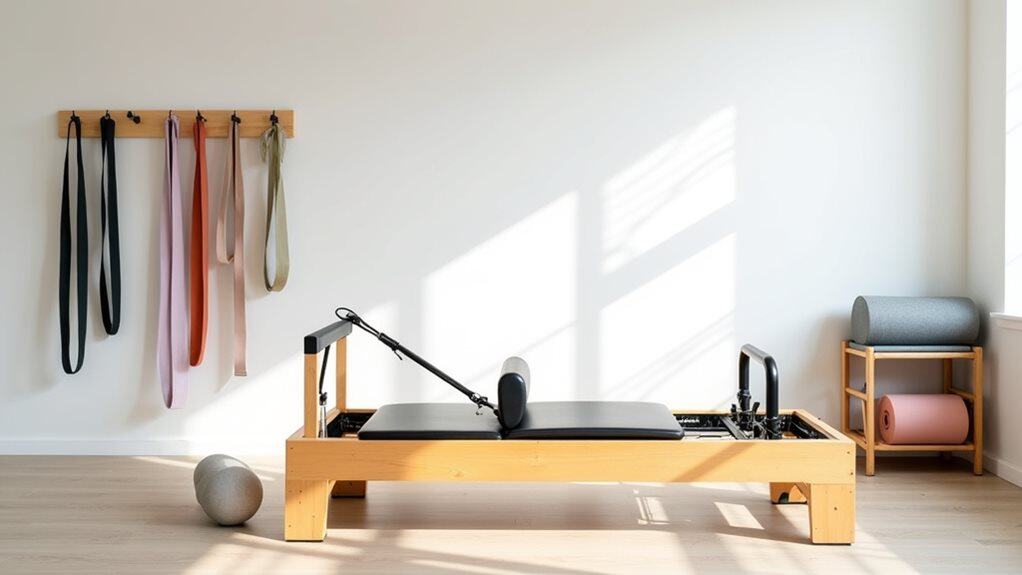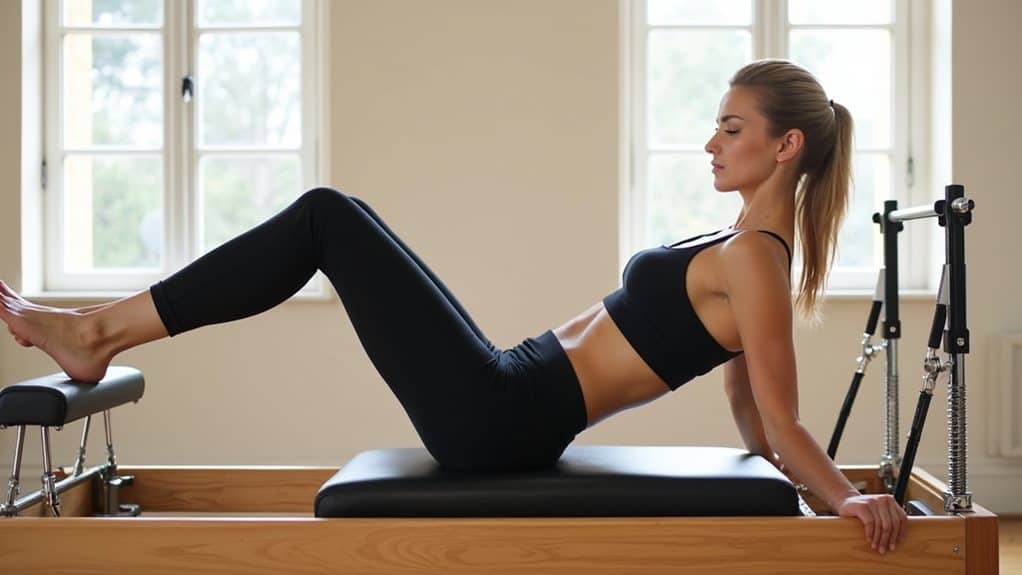Pilates classes have become very popular in recent years due to their versatility. Exercises can be tailored to each person’s fitness level allowing them to benefit from Pilates at whatever point they’re at in their health and fitness journey. You can choose to do a session at home, in a gym, or in a specialized studio.
In a Pilates session, the instructor will lead participants through a series of pre-designed, low-impact exercises, poses, and stretches. The goal of these exercises is to improve postural alignment and flexibility. The Pilates class will end with a few minutes focused on breathing and relaxing.
The rest of this article will talk more about what happens during a typical Pilates session. I’ll talk about the differences between Mat and Reformer Pilates and what to expect during the check-in, active movement, and final relaxation stages of a Pilates class.
What Is Pilates?
Pilates is a low-impact exercise method that emphasizes postural alignment, flexibility, and bodyweight strength exercises. The exercises are easy to follow and understand and can be tailored for individuals based on their flexibility and fitness levels.
It was created by Joseph Pilates, who drew on his experience working with injured soldiers in World War I to create an exercise program that utilizes bodyweight, breathing techniques, and mental conditioning. His work found great success in injury rehabilitation of soldiers, and he brought the same techniques to the health and fitness community after the war ended.
This YouTube video from Wellness provides more information about Pilates and what a typical class session may look like:
Mat Pilates Versus Reformer Pilates
There are two different kinds of Pilates classes: Mat Pilates and Reformer Pilates. Both classes focus on the same principles and can help you work the entire body, but use various techniques to perform the exercises.
In a mat class, participants will perform all the exercises on a thick mat rolled out on the ground. The mat is usually slightly thicker than a yoga mat and will help protect participants as they bend and stretch. Props, such as blocks, straps, and bolsters, can be used to help achieve optimal alignment and improve flexibility.
Although you will primarily use your own body weight, you may find some sessions make use of additional equipment such as small hand weights, resistance bands, small and large balls. These help add challenge and variety, helping you push your workout to the next level.
In a Reformer class, participants will use a special piece of equipment called the Reformer. The reformer has a bed-like frame that rolls back and forth.
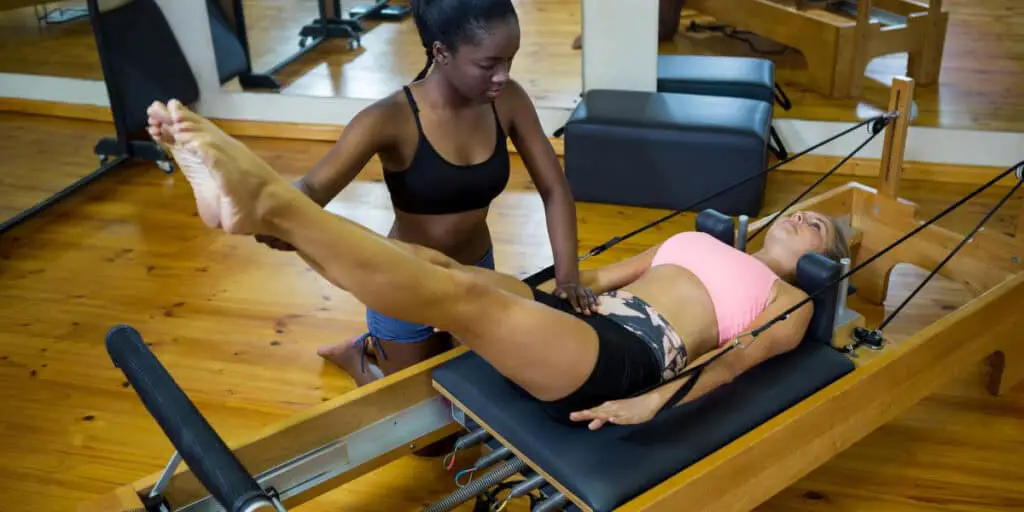
Springs allow for the resistance of the carriage bed to be adjusted in order to change the weight used during exercises. Reformers have foot and hand bars on each end, which can be used by participants to increase or decrease the difficulty of the movements.
For more information see: The Ultimate Guide to the Pilates Reformer
Is a Pilates Class the Same as a Yoga Class?
A Pilates class is not the same as a Yoga class. While the two have some areas of crossover and an emphasis on flexibility, breath work, and mind-body connection, they each use different exercises. Yoga classes work more on flexibility, while Pilates classes focus on strength.
Pilates exercises have a greater emphasis on engaging and utilizing the core muscles. While there is a flow to the movements, each exercise will pause for a set of muscle contractions before moving on to the next one.
Yoga classes will have a greater emphasis on mind-body connection. Many yoga classes emphasize a smooth and natural flow of movement, pausing to adjust how the body is aligned in each pose.
Some gyms and fitness studios will offer combination classes that bring together the best of both practices. These classes often use a yoga flow with Pilates exercises mixed in. This combination provides an opportunity to build strength and flexibility in a single exercise session.
To learn more about the differences, check out: How is Pilates different from Yoga?
Pilates Class Format
Going to a new exercise class can be an intimidating experience, but it’s not as difficult as you think. Here’s what to expect in a typical Pilates session.
Arrive Prepared
As with any new exercise class, it’s a good idea to arrive a few minutes early for your first session. Most studios will require students to sign a participation waiver and provide basic personal information. After filling out the paperwork, you can take off your shoes, Pilates is done with bare feet or grippy socks, and lay out your mat while waiting for class to begin.
Arriving early also allows you to introduce yourself to the instructor and let them know it’s your first time. You can also share any information about your own fitness and flexibility levels to better prepare them to assist you during the class.
If you become a regular, arriving early allows you to discuss your progress with your instructor and also catch up with other class participants, it’s a great way to get social.
The Five Essentials of Pilates
During class, all exercises will flow from five essentials:
- Breathing;
- Cervical alignment;
- Rib and scapular stabilization;
- Pelvic mobility;
- Engaging the transverses abdominis.
Each movement begins by engaging the core muscles and then moving the body through a controlled range of motion. You’ll contract and release different muscles to help build strength and improve mobility. Participants will perform each individual exercise five to ten times in a row before moving on to the next pose.
The various movements should feel challenging, especially as you repeat each action with the same muscle groups. You’ll need to focus intensely on each exercise to maintain the correct posture and alignment even as your muscles begin to fatigue. However, unlike traditional weight-building exercises, you will never work your muscles to exhaustion in a Pilates session.
Neutral Alignment
A primary focus during the Pilates class will be obtaining and maintaining neutral alignment. This focus means that your spine and cervix remain relaxed and neutral as the exercises are performed.
Focusing on neutral alignment means that your bones, muscles, joints, and tendons will be in the correct positions to perform the exercises safely and effectively.
This YouTube video from Beth Reading shows how to achieve neutral alignment, as well as how it plays an essential role during a class:
Breathe and Move
As you move through the exercises, you’ll need to focus simultaneously on your breathing and your movements.
Your breathing should be steady and controlled as you flow through the motions and complete each exercise. Many movements will focus on breathing out as you move in one direction, such as stretching out, and breathing in as you reverse the action, such as contracting.
Relax and Breathe
At the end of the class, the instructor will take a few moments to focus on relaxation and breathing. This part of a class may feel similar to a yoga class, which always ends with the Shavasana pose (corpse pose).
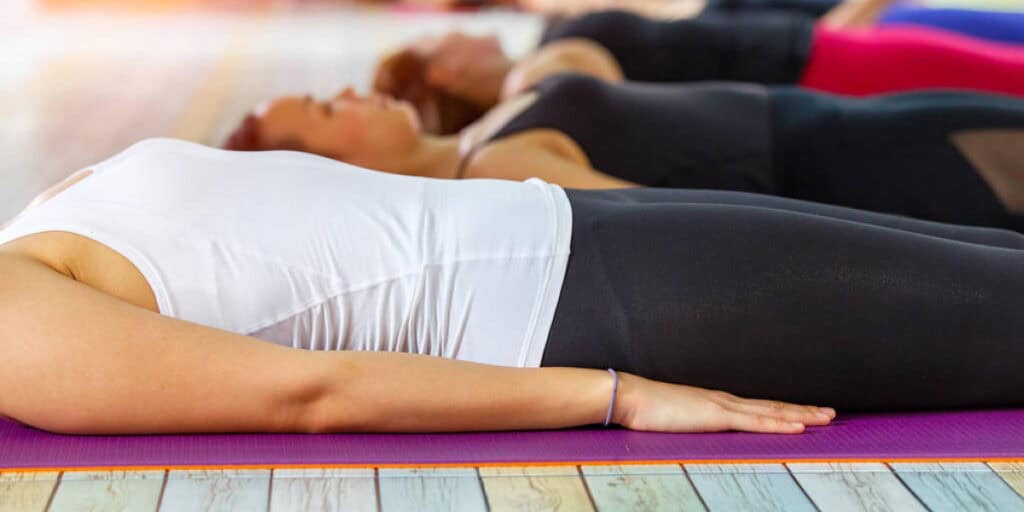
Participants will be asked to lay back and relax their muscles and mind. The instructor might provide a guided breathing exercise to help you focus on being in the present moment and connecting with each breath.
Other instructors may simply remind you to breathe in and out slowly before allowing time for personal breath work.
Final Thoughts
Pilates is a fantastic form of exercise to improve your postural alignment, flexibility, body awareness and overall muscular strength. As a low-impact full-body workout program, it’s accessible for people of all fitness levels. Props are used to help adjust alignment and provide support during challenging poses.
During a class, participants will perform a variety of bodyweight exercises that focus on engaging the whole body, emphasizing the core. In Mat Pilates classes, work is done on the mat, while a Reformer Pilates class will utilize specialized exercise equipment. Pilates classes will wrap up by focusing on relaxing and breathing.
Sources
- PubMed Central: Pilates: how does it work and who needs it?
- AARP: 10 Thing You Should Know About Pilates
- BetterHealth Channel: Pilates and yoga – health benefits
- Cleveland Clinic: Everything You Want to Know About Pilates
- NBC News: Reformer Pilates: What it is, who it’s best for and how to do some moves without the reformer
- Self: What is Pilates? 8 Things to Know Before You Take Your First Pilates Class
- YouTube: What to Expect in a Pilates Class (Livestream or In Studio)
- YouTube: What To Expect in your First Pilates Class
- Pilates Community: Lesson Plan
